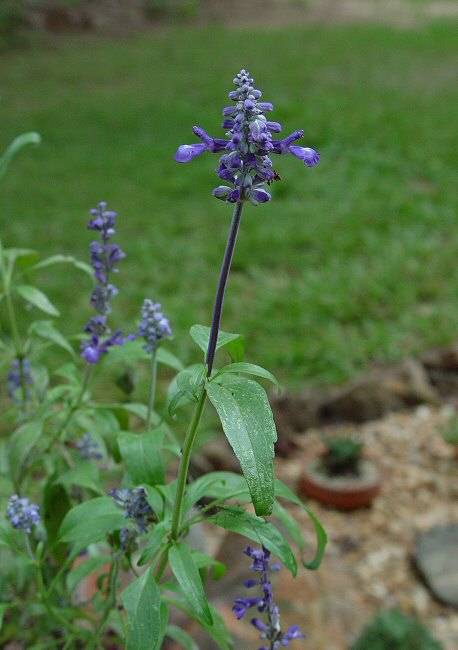Salvia farinacea Benth.
Mealycup Sage

Native
CC = n/a
CW =
MOC = 0
© DETenaglia
Salvia farinacea Benth.Mealycup Sage | |
 |
Native CC = n/a CW = MOC = 0 |
© DETenaglia |
|
Family - Lamiaceae Stems - To -1m tall, multiple from base, erect, herbaceous, from woody caudex, 4-angled, branching, densely retrorse pubescent.
Leaves - Opposite, decussate, petiolate. Petioles to 1.5cm long. Blade coarsely serrate, acute, +6cm long, +2cm broad, lanceolate, appressed pubescent(mostly on veins below), punctate.
Inflorescence - Terminal spikiform arrangement of verticillasters to +/-20cm long. +/-20 flowers per node. Axis of inflorescence striate, densely appressed pubescent.
Flowers - Corolla deep purple, bilabiate. Corolla tube to 6mm long, 2.5-3mm in diameter, contracted and white at base, purple above, densely pubescent near apex. Upper lip galeate, 5-6mm long, 3mm broad, densely pubescent externally. Lower lip 3-lobed. Lateral lobes to 5mm long, 2.4mm broad. Central lobe expanded, 1cm broad, notched at apex, whitish at base. Stamens 2, included under galea, with nectaries at base. Filaments white, 3mm long, glabrous. Anthers purplish, 1mm long nad broad. Style 1cm long, bearded(the hairs purple) at apex, 2-lobed at apex, inserted between stamens. Ovary 4-lobed, glabrous, green, with nectariferous ring at base. Calyx bilabiate, 6mm long, densely pubescent, purplish above, whitish below, +/-10-ribbed. Lips shallow and indistinct, glabrous and green internally.
Flowering - May - July. Habitat - Cultivated and sometimes persistent around old homesites. Origin - Native to Southwest U.S. Other info. - This species is frequently cultivated and can persist around abandoned homesites. This species is able to handle very dry and arid conditions and makes a good low maintenance addition to a garden. Its natural range is to the immediate southwest of Missouri. Wild populations have not yet been reported from the state. Photographs taken off Lee Rd 54, Auburn, AL., 8-20-04. |